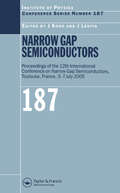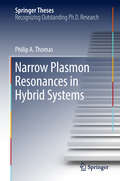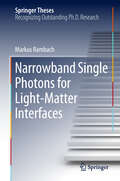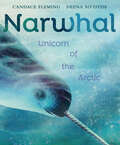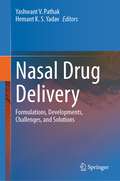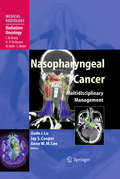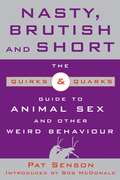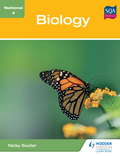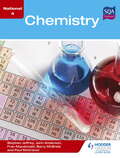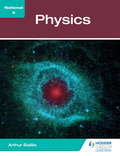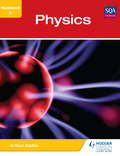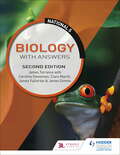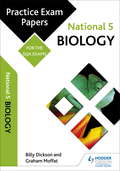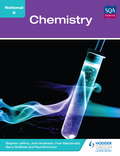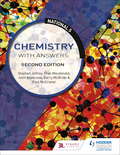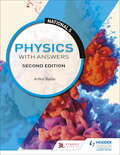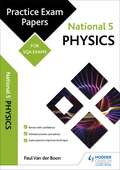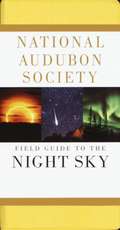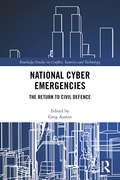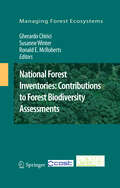- Table View
- List View
Narrow Gap Semiconductors: Proceedings of the 12th International Conference on Narrow Gap Semiconductors (Institute of Physics Conference Series)
by J Kono J LéotinThis volume forms a solid presentation in several important areas of NGS research, including materials, growth and characterization, fundamental physical phenomena, and devices and applications. It examines the novel material of InAs and its related alloys, heterostructures, and nanostructures as well as more traditional NGS materials such as InSb, PbTe, and HgCdTe. Several chapters cover carbon nanotubes and spintronics, along with spin-orbit coupling, nonparabolicity, and large g-factors. The book also deals with the physics and applications of low-energy phenomena at the infrared and terahertz ranges.
Narrow Plasmon Resonances in Hybrid Systems
by Philip A. ThomasAdvances in understanding the interactions between light and subwavelength materials have enabled the author and his collaborators to tailor unique optical responses at the nanoscale. In particular, metallic nanostructures capable of supporting surface plasmons can be designed to possess spectrally narrow plasmon resonances, which are of particular interest due to their exceptional sensitivity to their local environment. In turn, combining plasmonic nanostructures with other materials in hybrid systems allows this sensitivity to be exploited in a broad range of applications. In this book the author explores two different approaches to attaining narrow plasmon resonances: in gold nanoparticle arrays by utilising diffraction coupling, and in copper thin films covered by a protective graphene layer. The performance of these resonances is then considered in a number of applications. Nanoparticle arrays are used along with an atomic heterostructure as elements in a nanomechanical electro-optical modulator that is capable of strong, broadband modulation. Strong coupling between diffraction-coupled plasmon resonances and a gold nanoparticle array and guided modes in a dielectric slab is used to construct a hybrid waveguide. Lastly, the extreme phase sensitivity of graphene-protected copper is used to detect trace quantities of small toxins in solution far below the detection limit of commercial surface plasmon resonance sensors.
Narrowband Single Photons for Light-Matter Interfaces (Springer Theses)
by Markus RambachThis book provides a step-by-step guide on how to construct a narrowband single photon source for the integration with atom-based memory systems. It combines the necessary theoretical background with crucial experimental methods and characterisations to form a complete handbook for readers at all academic levels. The future implementation of large quantum networks will require the hybridisation of photonic qubits for communication with quantum memories in the context of information storage. Such an interface requires carefully tailored single photons to ensure compatibility with the chosen memory. The source itself is remarkable for a number of reasons, including being the spectrally narrowest and brightest source of its kind; in addition, it offers a novel technique for frequency stabilisation in an optical cavity, together with exceptional portability. Starting with a thorough analysis of the current literature, this book derives the essential parameters needed to design the source, describes its individual components in detail, and closes with the characterisation of a single photon source.
Narwhal: Unicorn of the Arctic
by Candace FlemingVenture to the Arctic Ocean and discover real life underwater unicorns--narwhals--in this stunningly illustrated nonfiction picture book.You are a narwhal.Shy... Swift... Small...Humans call you unicorn of the Arctic.When winter ice covers the Arctic Ocean, a narwhal pokes his head through a patch of open water, his tusk--a six-foot long tooth--pointed to the sky.Join this mammal as he jousts with another narwhal, floats with his pod, and uses echolocation to find his prey. When warmer weather arrives, he will migrate towards summer ground. But he must be careful! Predators--orcas and polar bears--will be hungry and looking for a meal.... How will the narwhal escape? Will he be able to return to the winter bay? Paired with atmospheric illustrations by debut illustrator Deena So'Oteh, nonfiction master Candace Fleming delivers a picture book, uniquely told in second person, that expertly explores the mysterious and fascinating unicorn of the Arctic.
Nasal Drug Delivery: Formulations, Developments, Challenges, and Solutions
by Yashwant V. Pathak Hemant K. S. YadavThis book addresses the recent trends and clinical research being reported in last 5 to 10 years in the field of nasal drug delivery systems. In recent years, interest in using nasal passage as drug absorption site has received increased attention from formulation scientists. Nasal passages, even though a small surface area of the body as compared to other absorption passage such as Gastrointestinal tract or skin, show significant possibility for drug absorption at a quicker rate. There is also a possibility of delivering drugs to the brain using this passage and targeting drugs through the nasal passage. The book has 19 chapters addressing various aspects of nasal drug delivery systems such as an overview of anatomy and physiology of the nasal passage from a drug delivery point of view to global market opportunities for nasal drug delivery. In between, it addresses various aspects of nasal drug delivery. There are very few titles exclusively dedicated to nasal drug delivery, covering the formulation and developmental aspects, and addressing the challenges and solutions. The primary audiences for the book are graduate students in field of medicine, pharmacy and also various researchers who are working in the area of nasal drug delivery in addition to students who are specializing in field of medicine in ENT. This book provides comprehensive information on all the aspects related to the nasal drug delivery of various drug molecules.
Nasopharyngeal Cancer
by Jay S. Cooper Anne W. Lee Jiade J. LuNasopharyngeal Cancer - Multidisciplinary Management provides a comprehensive account of the current state of knowledge on nasopharyngeal cancer and its multidisciplinary management. The first ten chapters document contain essential background information on subjects such as epidemiology, pathogenesis, molecular biology, pathology, and the use of imaging in diagnosis and staging. Subsequently, the various treatment options and combinations in a range of settings are examined in depth. Detailed attention is given to the roles of concurrent, adjuvant, and neoadjuvant chemotherapy and advanced radiotherapy techniques. Further chapters then explore surgical treatment, follow-up, treatment of metastatic disease, treatment-related complications, and nasopharyngeal cancer in children. This is an important book that will prove essential reading for the radiation oncology community worldwide and meet the need for substantial improvements in knowledge of modern techniques.
Nasty, Brutish, and Short: The Quirks and Quarks Guide to Animal Sex and Other Weird Behaviour
by Pat SensonBirds do it, and bees do it, so do all animals, some of them in weird and wonderful ways. Quirks & Quarks' latest book explores the more bizarre behaviours of more than 100 creatures, from barnacles to Panda bears. The tiny spider that has to tear off one of its two huge sex organs just to be able to get around; the sea slug that produces a powerful love drug and mates with both males and females; the bedbug that stabs its penis into the female's abdomen -- the range of animal sexual practices is mind-boggling. And it's not only reproduction that has them doing very strange things. There's a beetle that shoots a stream of boiling hot, toxic liquid when it's threatened; a lizard that can run on water; a shrimp that explodes its prey. Quirks & Quarks' latest guide is much more than a catalogue of peculiar practices, it's an engrossing look at the astonishing behaviours different animals have evolved in order to survive and reproduce. With an introduction by Bob McDonald, host of Quirks & Quarks.
National 4 Biology
by Nicky SouterThis book is a comprehensive resource for pupils studying National 4 Biology, which adheres closely to the SQA syllabus. Each section of the book matches a mandatory unit of the syllabus, and each chapter corresponds to a key area.In addition to the core text, the book contains a variety of special features:· Activities to consolidate learning· Worked examples to demonstrate key processes· In-text questions to test knowledge and understanding· End-of-chapter questions for homework and assessment· Summaries of key facts and concepts· Integrated advice on the Added Value Unit· Answer section at the back of the book
National 4 Chemistry
by John Anderson Fran Macdonald Stephen Jeffrey Barry McBride Paul McCranorExam Board: SQALevel: National 4Subject: ScienceFirst Teaching: September 2013First Exam: June 2014This book is a comprehensive resource for pupils studying National 4 Chemistry which adheres closely to the SQA syllabus. Each section of the book matches a mandatory unit of the syllabus, and each chapter corresponds to a key area. In addition to the core text, the book contains a variety of special features:· Activities to consolidate learning and help in preparing for the Added Value Unit· Worked examples to demonstrate key processes· In-text questions to test knowledge and understanding· End-of-chapter questions for homework and assessment· Summaries of key facts and concepts· Answer section at the back of the book
National 4 Chemistry
by Fran Macdonald Barry Mcbride Stephen JeffreyThis book is a comprehensive resource for pupils studying National 4 Chemistry which adheres closely to the SQA syllabus. Each section of the book matches a mandatory unit of the syllabus, and each chapter corresponds to a key area. In addition to the core text, the book contains a variety of special features:· Activities to consolidate learning and help in preparing for the Added Value Unit· Worked examples to demonstrate key processes· In-text questions to test knowledge and understanding· End-of-chapter questions for homework and assessment· Summaries of key facts and concepts· Answer section at the back of the book
National 4 Physics
by Arthur BaillieExam Board: SQALevel: National 4Subject: ScienceFirst Teaching: September 2013First Exam: June 2014This book is a comprehensive resource for pupils studying National 4 Physics which adheres closely to the SQA syllabus. Each section of the book matches a mandatory unit of the syllabus, and each chapter corresponds to a key area. In addition to the core text, the book contains a variety of special features:· Activities to consolidate learning· Worked examples to demonstrate key processes· In-text questions to test knowledge and understanding· End-of-chapter questions for homework and assessment· Summaries of key facts and concepts· Special section on the Added Value Unit· Answer section at the back of the book
National 4 Physics
by Arthur BaillieThis book is a comprehensive resource for pupils studying National 4 Physics which adheres closely to the SQA syllabus. Each section of the book matches a mandatory unit of the syllabus, and each chapter corresponds to a key area. In addition to the core text, the book contains a variety of special features:· Activities to consolidate learning· Worked examples to demonstrate key processes· In-text questions to test knowledge and understanding· End-of-chapter questions for homework and assessment· Summaries of key facts and concepts· Special section on the Added Value Unit· Answer section at the back of the book
National 5 Biology with Answers, Second Edition
by James Simms Clare Marsh Caroline Stevenson James Fullarton James TorranceExam Board: SQALevel: National 5Subject: BiologyFirst Teaching: August 2017First Exam: May 2018The second edition of this textbook covers all recent revisions to course content, incorporating essential new material whilst retaining the unique style of the original. The new edition contains:- Streamlined chapters differentiate between mandatory core text and non-mandatory activities- Testing Your Knowledge: Key questions for homework and assessment- What You Should Know : Summaries of key facts and concepts- Applying Your Knowledge and Skills: Problem-solving exercises for exam practice
National 5 Biology with Answers: Second Edition Epub
by Clare Marsh Caroline Stevenson James TorranceExam Board: SQALevel: National 5Subject: BiologyFirst Teaching: August 2017First Exam: May 2018The second edition of this textbook covers all recent revisions to course content, incorporating essential new material whilst retaining the unique style of the original. The new edition contains:- Streamlined chapters differentiate between mandatory core text and non-mandatory activities- Testing Your Knowledge: Key questions for homework and assessment- What You Should Know : Summaries of key facts and concepts- Applying Your Knowledge and Skills: Problem-solving exercises for exam practice
National 5 Biology: Practice Papers for SQA Exams
by Graham Moffat Billy DicksonPractise for your SQA exams with three specially-commissioned Hodder Gibson Practice Exam Papers with fully-worked answers.- Practise with model papers written and checked by experienced markers and examiners- Worked answers show how answers are arrived at and where marks are gained- Get extra advice with study-skills guidance sections- Gain vital extra marks and avoid common mistakes with examiner tips- A revision grid allows revision by topic
National 5 Chemistry
by John Anderson Fran Macdonald Barry McbrideA full course textbook for the new National 5 Chemistry syllabus, endorsed by SQA!This book is designed to act as a valuable resource for pupils studying National 5Chemistry. It provides a core text which adheres closely to the SQA syllabus, witheach section of the book matching a unit of the syllabus, and each chaptercorresponding to a content area. It is an ideal - and comprehensive - teaching andlearning resource for National 5 Chemistry. In addition to the core text, the bookcontains a variety of special features: For Interest, Key Terms, Activities, Worked Examples, Questions, Prescribed Practical Activities, Summary, and Checklist for Revision.- The only textbook for the National 5 Chemistry syllabus offered by SQA, as examined 2014 onwards- Bestselling author team, with extremely high reputation for Scottish Chemistry titles- Full colour presentation and motivating text design to encourage student enthusiasm
National 5 Chemistry with Answers, Second Edition
by John Anderson Fran Macdonald Stephen Jeffrey Barry McBride Paul McCranorExam Board: SQALevel: National 5Subject: ChemistryFirst Teaching: September 2017First Exam: Summer 2018The second edition of this textbook has been fully revised and updated to reflect changes made tothe SQA syllabus from 2017 onwards. New features include:- Refreshed content- Additional candidate advice- Model answers for open-ended questions.
National 5 Chemistry with Answers: Second Edition Epub
by John Anderson Stephen Jeffrey Barry McBrideExam Board: SQALevel: National 5Subject: ChemistryFirst Teaching: August 2017First Exam: May 2018The second edition of this textbook has been fully revised and updated to reflect changes made tothe SQA syllabus from 2017 onwards. New features include:- Refreshed content- Additional candidate advice- Model answers for open-ended questions.
National 5 Chemistry: Practice Papers for SQA Exams
by Barry McbridePractise for your SQA exams with three specially-commissioned Hodder Gibson Practice Exam Papers with fully-worked answers.- Practise with model papers written and checked by experienced markers and examiners- Worked answers show how answers are arrived at and where marks are gained- Get extra advice with study-skills guidance sections- Gain vital extra marks and avoid common mistakes with examiner tips- A revision grid allows revision by topic
National 5 Physics with Answers, Second Edition
by Arthur BaillieExam Board: SQALevel: National 5Subject: PhysicsFirst Teaching: September 2017First Exam Summer 2018This second edition has been comprehensively updated to reflect the changes made by the SQA to the National 5 Course Specification with chapters on the following areas of physics: Electricity, Properties of matter, Waves, Radiation, Dynamics, and Space.- Covers the new specification with all the new topics in the SQA examinations- Provides thorough exam preparation, with practice exercises- Organised to make it easy to plan, manage and monitor student progress
National 5 Physics with Answers: Second Edition Epub
by Arthur BaillieExam Board: SQALevel: National 5Subject: PhysicsFirst Teaching: August 2017First Exam: May 2018This second edition has been comprehensively updated to reflect the changes made by the SQA to the National 5 Course Specification with chapters on the following areas of physics: Electricity, Properties of matter, Waves, Radiation, Dynamics, and Space.- Covers the new specification with all the new topics in the SQA examinations- Provides thorough exam preparation, with practice exercises- Organised to make it easy to plan, manage and monitor student progress
National 5 Physics: Practice Papers for SQA Exams
by Paul VanderboonPractise for your SQA exams with three specially commissioned Hodder Gibson Practice Exam Papers with fully worked answers.- Practise with model papers written and checked by experienced markers and examiners- Worked answers show how solutions are arrived at and where marks are gained- Get extra advice with study-skills guidance sections- Avoid common mistakes with examiner tips- A revision grid allows students to revise by topic
National Audubon Society® Field Guide to the Night Sky
by Wil Tirion Mark R. Chartrand National Audubon Society StaffThe perfect companion volume for Hale-Bopp watchers, this guide explores the fabulous mysteries above, from planets in our solar system to the constellations in both the Northern and Southern hemispheres, stars, galaxies (including the Milky Way), nebulae, astronomical bodies, objects, phenomena, and -- yes -- comets. Night Sky provides a concise guided tour of the heavens with 48 monthly sky charts of the northern sky and 88 constellation charts, each offering a detailed map of individual constellations. Essays on the universe, the solar system, and constellations introduce the reader to the wonders of the sky.
National Cyber Emergencies: The Return to Civil Defence (Routledge Studies in Conflict, Security and Technology)
by Greg Austin OliverThis book documents and explains civil defence preparations for national cyber emergencies in conditions of both peace and war. The volume analyses the escalating sense of crisis around state-sponsored cyber attacks that has emerged since 2015, when the United States first declared a national emergency in cyberspace. It documents a shift in thinking in the USA, from cooperative resilience-oriented approaches at national level to more highly regulated, state-led civil defence initiatives. Although the American response has been mirrored in other countries, the shift is far from universal. Civil defence strategies have come into play but the global experience of that has not been consistent or even that successful. Containing contributions from well-placed scholars and practitioners, this volume reviews a selection of national experiences (from the USA, Australia, India, China, Estonia, and Finland) and a number of key thematic issues (information weapons, alliance coordination, and attack simulations). These demonstrate a disconnect between the deepening sense of vulnerability and the availability of viable solutions at the national level. Awareness of this gap may ultimately lead to more internationally oriented cooperation, but the trend for now appears to be more conflictual and rooted in a growing sense of insecurity. This book will be of much interest to students of cyber security, homeland security, disaster management, and international relations, as well as practitioners and policy-makers.
National Forest Inventories: Contributions to Forest Biodiversity Assessments
by Susanne Winter Ronald E. Mcroberts Gherardo ChiriciForest biodiversity is crucial to the ecological, economic, and social well-being of earth's civilisations. Unfortunately, however, forest biodiversity is threatened to a serious degree in nearly all countries. Therefore, many countries have agreed to be parties to international agreements focused on maintaining, restoring, and monitoring biodiversity; further, these countries have agreed to report to international bodies on forest biodiversity status and trends. NFIs are the primary source of large-scale information available for this purpose, but the large variety of definitions, protocols, sampling designs, and plot configurations used by NFIs makes comparable international reporting extremely difficult. This book presents the results of Working Group 3 of COST Action E43 in the development of harmonization techniques for common reporting of estimates of forest biodiversity indicators using NFI data. Harmonization tests were carried out on a large common data base containing raw NFI data from 13 European countries and the USA. With its collection of practical examples for the estimation of forest biodiversity indicators, it's a practical tool for anyone involved in forest inventories and in forest resource monitoring and management as well as for those involved in biodiversity assessment and reporting.
